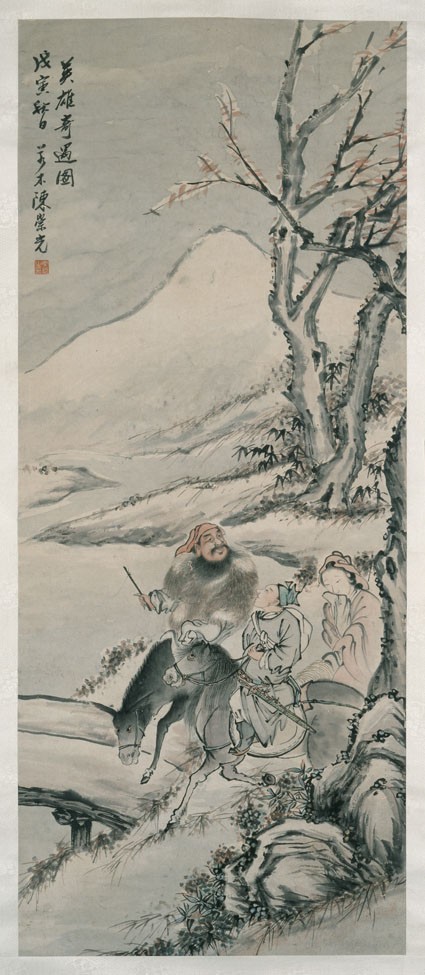Beauties and Heroes: Legends and Stories in Chinese Art
(from 21st Jan until 15th Jul 2012)Explore paintings, prints and papercuts depicting legendary figures from Chinese folklore.

The Hero's Happy Encounter
-
Description
Chen Chongguang, also known as Ruomu, is a painter and poet from Yangzhou, Jiangsu province who strictly follows the traditional style of Chinese painting. His use of calligraphic paint strokes is particularly evident on the clothes of the three heroes in this painting.
Depicted in this painting are three legendary figures that played key roles in the establishment of the powerful Tang Empire (AD 618-907). According to the story, Qiuranke (the Knight of Big Beard) (left) wanted to take over the throne in the chaos of war. He then met Hongfunü (Lady of Red Horsetail-Whisk) (right) and her husband Li Jing (centre). Hongfunü, who excelled at kung fu, had left her former master and eloped with Li, in whom she saw political talent. Through this couple, Qiuranke got to meet Li Shimin (AD 599-649), who he immediately recognized as the ‘Son of Heaven’. Qiuranke therefore gave up his ambition and left all his fortune to the couple to support Li Shimin, who eventually became one of the greatest emperors in history, Emperor Taizong (r. AD 627-649). This Tang legend, revised to show the legitimacy of the dynasty, has since been adapted into dramas, martial novels and movies.
-
Details
- Associated place
-
Asia › China › Jiangsu province › Yangzhou (place of creation)
- Date
- 1878
- Artist/maker
-
Chen Chongguang (1839 - 1896) (artist)
- Associated people
-
Li Jing (AD 571 - 649) (subject)
- Material and technique
- ink and colour on paper
- Dimensions
-
mount 220 x 62 cm (height x width)
painting 127 x 52 cm (height x width)
along roller 70 cm (length)
- Material index
- Technique index
- Object type index
- No. of items
- 1
- Credit line
- Purchased, 1966.
- Accession no.
- EA1966.85
-
Further reading
Vainker, Shelagh, Chinese Paintings in the Ashmolean Museum, Oxford (Oxford: Ashmolean Museum, 2000), no. 4 on p. 26, illus. p. 27 fig. 4
Past Exhibition
see (1)Location
-
- currently in research collection
Objects are sometimes moved to a different location. Our object location data is usually updated on a monthly basis. Contact the Jameel Study Centre if you are planning to visit the museum to see a particular object on display, or would like to arrange an appointment to see an object in our reserve collections.
Publications online
-

Chinese Paintings in the Ashmolean Museum, Oxford
Chen Chongguang was born in Yangzhou, Jiangsu province. Before studying painting, he worked as a woodcarver.
Notice
Objects from past exhibitions may have now returned to our stores or a lender. Click into an individual object record to confirm whether or not an object is currently on display. Our object location data is usually updated on a monthly basis, so please contact the Jameel Study Centre if you are planning to visit the museum to see a particular Eastern Art object.
© 2013 University of Oxford - Ashmolean Museum


